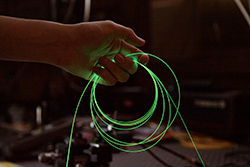On the topic of optics and optoelectronics, the international society for optics and photonics SPIE organizes every second year the Optics + Optoelectronics Symposium, which takes place in Prague’s Congress Hotel Clarion in Vysočany from 1 to 4 April. In addition to the fact that specialists from ÚFE chair four of the 18 sub-conferences, this year they have prepared a novelty – a specialised workshop and a subsequent excursion to the optical fibre technology laboratories in Prague’s Suchdol. A distinguished guest of the programme will be Erich Spitz, a French physicist of Czech origin, who will commemorate the pulling out of the world’s first single-mode optical fibre.
One of the main topics of the SPIE Optics + Optoelectronics symposium is fiber lasers and optical fibers. Therefore, researchers from the Institute of Photonics and Electronics will lead a workshop on fiber optic technology with an emphasis on fiber lasers during the SPIE symposium. How to increase the efficiency of fibre lasers? How to generate new wavelengths? Will we see a rebirth of gas lasers thanks to hollow fiber lasers? Pavel Honzátko, head of the Fiber lasers and non-linear optics team at the ÚFE, will try to answer these and other questions in his talk Future Trends in Fiber Optics. „Fiber lasers are distinguished by their high electro-optical efficiency – even up to around 50%, high power and a high-quality beam that can be focused over a long distance. Therefore, they are finding increasing use in industry and their use in security applications such as defence against drones or improvised explosive devices is being explored,” Pavel Honzátko highlights their unique properties.
Optical fibre pulling scheme
Participants of the SPIE symposium will have the opportunity to take a look into the laboratory of optical fibre technology of the Institute of Fiber Optics. The excursion will show the most modern directions of research on special optical fibres and will also remind the forty-year history since the start of research on optical fibre technology in Czechoslovakia in 1979. Today, this laboratory is unique in the Czech Republic and is one of only a few dozen workplaces that can prepare special optical fibres for high-power fibre lasers. The special optical fibres and fibre devices developed at ÚFE are used in many other research institutes in the Czech Republic and worldwide, as well as in industry.
The Waveguiding Principle of Light
Today, we hardly even acknowledge that fibre optics was initially a neglected invention, but later it managed to change the world, especially in the field of telecommunications, e.g. with the introduction of the Internet. Erich Spitz, Honorary Chairman of the Symposium and long-time Research Director at the French company Thales, will commemorate the launch of the world’s very first single-mode fibre. The origins of fibre optics thus bear a Czech trace, as Erich Spitz comes from the former Czechoslovakia, from where he emigrated in the 1950s. He headed one of only two laboratories in the world where its scientists were researching optical fibres for telecommunications in the early 1960s. Later, he also conducted the first successful experiment for image transmission over a single multimode optical fibre. Such an image transmission system would revolutionize endoscopes for medicine and is now a hot topic. Among the world’s leading experts in this field are Tomáš Čižmár and his team from the Institute of Instrumentation Technology of the Czech Academy of Sciences in Brno. His lecture will also be given at the symposium. Other lectures will focus on the technology of production of optical fibres and fibre components.

